A benchtop bandsaw is a versatile and essential tool for any woodworker or hobbyist. It is a compact, yet powerful machine that can cut through a variety of materials with precision and ease. The bandsaw gets its name from the thin, flexible, and continuous steel strip with teeth on one edge that is looped over two wheels. The tool’s design allows for intricate and accurate cuts, making it a favorite among craftsmen.
Unlike larger, floor-standing models, benchtop bandsaws are designed to be portable and space-saving. Despite their smaller size, they offer considerable power and functionality. They are perfect for small to medium-sized projects and are an excellent addition to any workshop where space might be at a premium.
Understanding the capabilities and features of a benchtop bandsaw is crucial for anyone considering investing in one. This article aims to provide a comprehensive guide on everything you need to know about benchtop bandsaws, from their importance and key features to their maintenance needs and price range.
Our Top Benchtop Bandsaw Picks
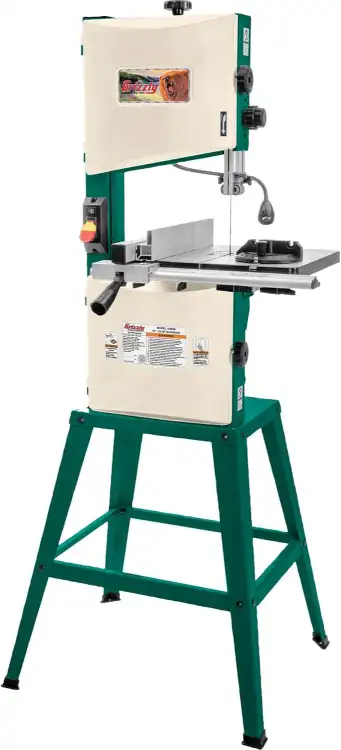
Grizzly Industrial G0948 10″ 1/2 HP Bandsaw
Check on AmazonKey Specs:
- Blade Material: Steel
- Power Source: Corded Electric
- Table Tilt: 0–45° for miters
- Dust Ports: 2″, 3″, 4″ combination
- Features: Adjustable blade guides, ergonomic knobs, LED work light
The Grizzly Industrial G0948 10″ Bandsaw is a powerful and versatile tool, designed to handle woodworking and light metal cutting tasks. The extruded aluminum fence ensures precise ripping and resawing of veneers, while the steel stand with vibration-resistant rubber feet provides stability during operation. Equipped with a 0-45° adjustable table for easy miters and two-speed cutting options, this bandsaw offers flexibility and precision. Its fully adjustable ball-bearing blade guides, ergonomic knobs, and built-in LED light enhance ease of use, while the wheel brush keeps the bottom tire clean.
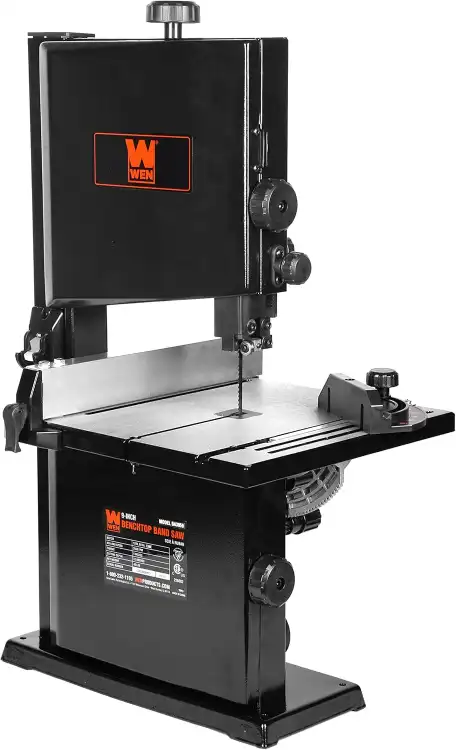
WEN 9-Inch Band Saw, 2.8-Amp Benchtop
Check on AmazonKey Specs:
- Motor: 2.8 amps, up to 2500 FPM
- Cutting Capacity: 3-1/2″ deep, 9″ wide
- Blade Size: 59-1/2″ (1/8″ to 3/8″ wide)
- Table Size: 12-1/4″ x 11-7/8″, bevels up to 45°
- Includes: 1/4″ blade, rip fence, miter gauge, dust port
The WEN 9-Inch Band Saw is a compact yet powerful benchtop tool designed for precision and convenience. With a 2.8-amp motor and a blade speed of up to 2500 feet per minute, this saw can cut through wood with ease, offering a cutting capacity of 3-1/2 inches deep and 9 inches wide. The spacious work table bevels up to 45 degrees, and the included accessories, such as the rip fence and miter gauge, enhance versatility. The 2-1/2-inch dust port ensures a cleaner work environment.
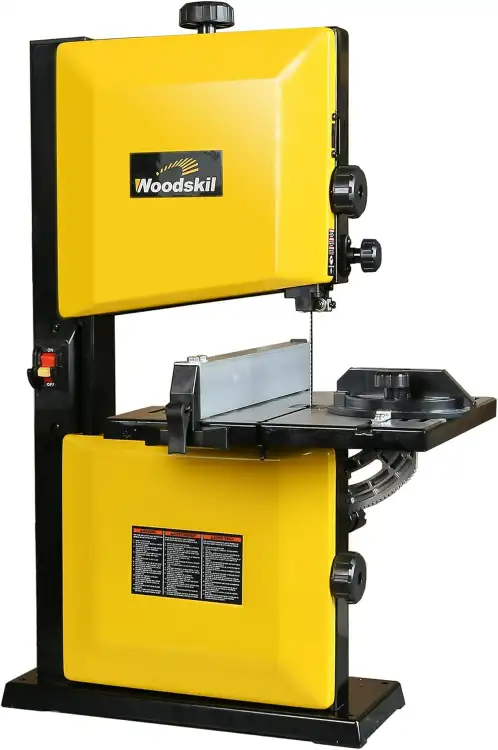
3-Amp 9-Inch Band Saw, 2500FPM Benchtop Bandsaw
Check on AmazonKey Specs:
- Motor Speed: 1720 RPM, Blade Speed: 2500 FPM
- Cutting Capacity: 3-1/2″ depth, 9″ width
- Blade Size: 59-1/2″ (1/8″ to 3/8″ wide)
- Table Size: 12-5/16″ x 11-7/8″, tilts 0° to 45°
- Includes: Rip fence, miter gauge, 2-1/2″ dust port
The 3-Amp 9-Inch Band Saw delivers powerful and efficient cutting performance with a 2500 FPM blade speed and 1720 RPM motor. It features a 59-1/2 inch blade with a width range of 1/8 to 3/8 inches, cutting wood and soft metals with ease. The cast aluminum table tilts from 0° to 45°, and the miter gauge ensures accuracy for various angles. A sturdy steel base and dust collection system keep your workspace clean and stable.
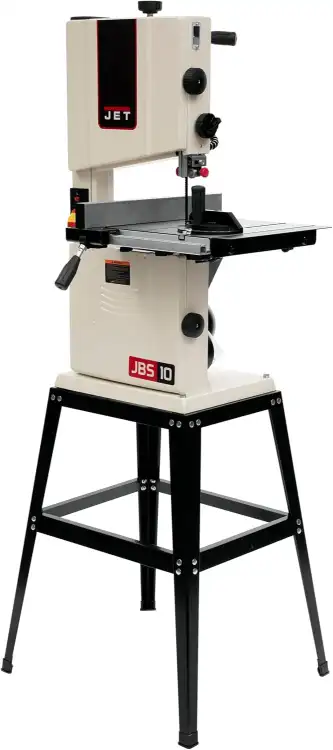
JET 10-Inch Woodworking Bandsaw
Check on AmazonKey Specs:
- Motor: 1/2-HP induction motor
- Blade Material: High carbon steel
- Cutting Capacity: 10-inch blade
- Fence: Aluminum extruded, smooth sliding
- Features: Quick-release blade tension, upper/lower ball bearing guides
The JET 10-Inch Woodworking Bandsaw is designed for versatility and portability, offering a compact benchtop design that easily transitions to the floor with its rigid steel stand. The powerful 1/2-HP induction motor handles various cutting tasks, while the Poly-V drive system enhances power transfer and minimizes vibration. The upper and lower ball bearing blade guides provide stability, and the quick-release blade tension feature allows for easy blade changes. The aluminum extruded fence ensures smooth, precise cuts.
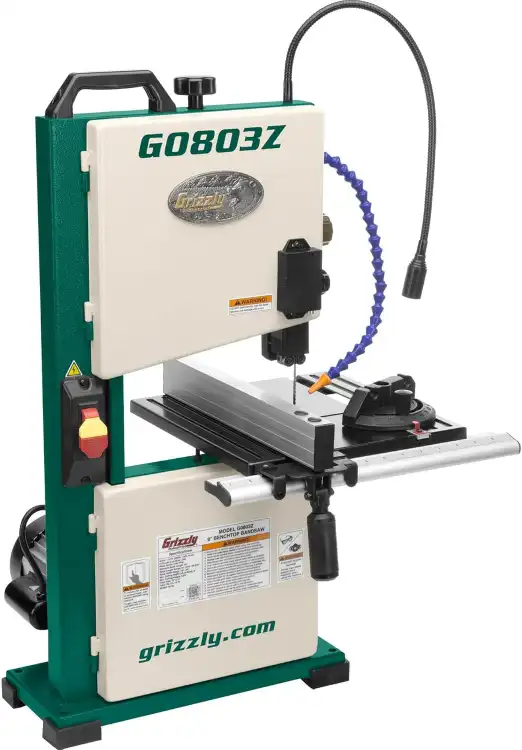
Grizzly Industrial 9″ Benchtop Bandsaw
Check on AmazonKey Specs:
- Blade Material: Carbon steel
- Features: Dust collection system
- Table Tilt: Rack-and-pinion
- Blade Guides: Ball-bearing
- Adjustments: Quick-release blade tension, adjustable fence
The Grizzly Industrial 9″ Benchtop Bandsaw is built for precision and durability, featuring adjustable wheels for blade alignment and a fence that adjusts for accurate blade lead. Its rack-and-pinion table tilt provides easy angle adjustments, while the ball-bearing blade guides ensure smooth, stable cutting. The quick-release blade tension levers make blade changes quick and hassle-free. Additionally, the built-in dust collection system keeps your workspace clean.
Understanding the Importance of Benchtop Bandsaws
Benchtop bandsaws are an indispensable tool in woodworking. They offer a level of versatility that few other tools can match. With a benchtop bandsaw, you can make a variety of cuts, including crosscuts, rip cuts, and even intricate curved cuts. This versatility makes it an essential tool for any serious woodworker.
Moreover, benchtop bandsaws are designed to be compact and portable. This makes them ideal for small workshops or for those who need to transport their tools frequently. Despite their size, they pack a punch in terms of power and performance, allowing you to handle a wide range of tasks with ease.
Finally, benchtop bandsaws are known for their precision. The blade’s thinness allows for a high degree of accuracy, making it possible to make intricate cuts with ease. This precision, combined with the tool’s power and versatility, makes the benchtop bandsaw a valuable asset in any workshop.
Key Features to Look for in a Benchtop Bandsaw
When shopping for a benchtop bandsaw, there are several key features to look for. First and foremost is the size of the bandsaw. The size of the bandsaw will determine the size of the material you can cut. Most benchtop bandsaws have a cutting capacity of 9 to 12 inches, which is sufficient for most small to medium-sized projects.
Another important feature to consider is the power of the bandsaw. The power of the bandsaw will determine the thickness of the material you can cut. Most benchtop bandsaws have a power range of 2.5 to 3.5 amps, which is enough to cut through most types of wood and some metals.
Finally, consider the bandsaw’s speed settings. Different materials require different cutting speeds, so a bandsaw with variable speed settings will give you more versatility. Some bandsaws also come with a built-in dust collection system, which can help keep your workspace clean and safe.
Power and Performance of Benchtop Bandsaws
The power of a benchtop bandsaw is a critical factor to consider when making a purchase. The power of the bandsaw, often measured in horsepower or amps, determines the thickness and type of material it can cut. Most benchtop bandsaws have a power range of 2.5 to 3.5 amps, which is enough to cut through most types of wood and some metals.
However, power is not the only factor that determines the performance of a bandsaw. The design and quality of the blade also play a significant role. A high-quality blade can improve the performance of the bandsaw, allowing for smoother and more precise cuts.
Finally, the speed of the bandsaw also affects its performance. Different materials require different cutting speeds, so a bandsaw with variable speed settings will give you more versatility. Some bandsaws also come with a built-in dust collection system, which can help keep your workspace clean and safe.
The Role of Throat Capacity in Benchtop Bandsaws
Throat capacity is another critical factor to consider when choosing a benchtop bandsaw. The throat capacity refers to the distance between the blade and the vertical frame section of the bandsaw. This distance determines the width of the material that the bandsaw can cut.
Most benchtop bandsaws have a throat capacity of 9 to 12 inches. This is sufficient for most small to medium-sized projects. However, if you plan on working with larger pieces of material, you may need a bandsaw with a larger throat capacity.
It’s important to note that while a larger throat capacity allows for wider cuts, it does not affect the depth of cut the bandsaw can make. The depth of cut is determined by the distance between the table and the upper blade guides and is usually around 6 inches for most benchtop bandsaws.
Importance of Blade Quality and Variety in Benchtop Bandsaws
The quality and variety of blades available for a benchtop bandsaw are crucial factors to consider. The blade is the part of the bandsaw that does the actual cutting, and its quality can significantly affect the performance of the bandsaw.
High-quality blades are designed to stay sharp for longer, reducing the need for frequent replacements. They also tend to produce smoother and more precise cuts. Some high-quality blades also feature a variable tooth set, which can help reduce vibration and improve cutting performance.
In addition to quality, the variety of blades available for a bandsaw is also important. Different types of cuts and materials require different types of blades. For example, a blade with a high tooth count is best for making precise, intricate cuts, while a blade with a low tooth count is better for making quick, rough cuts. Having a variety of blades at your disposal will allow you to tackle a wider range of projects.
Evaluating the Durability and Construction of Benchtop Bandsaws
When investing in a benchtop bandsaw, it’s important to consider the durability and construction of the machine. A well-constructed bandsaw will not only last longer, but it will also provide more stable and accurate cuts.
One of the key factors to consider is the material used in the construction of the bandsaw. Bandsaws made from cast iron or steel tend to be more durable and stable than those made from plastic or aluminum. However, they are also heavier and less portable.
Another factor to consider is the design of the bandsaw. Bandsaws with a well-designed frame and a sturdy table will provide better support for the material you are cutting, resulting in more accurate cuts. Additionally, look for bandsaws with a blade tensioning system, as this can help prolong the life of the blade and improve cutting performance.
The Significance of Speed Settings in Benchtop Bandsaws
The speed of a benchtop bandsaw is a critical factor to consider. Different materials require different cutting speeds, so a bandsaw with variable speed settings will give you more versatility. For example, wood requires a slower cutting speed than metal, so a bandsaw with a variable speed setting will allow you to switch between different materials with ease.
Most benchtop bandsaws have a speed range of 500 to 3500 feet per minute (FPM). This range is sufficient for most materials, but if you plan on cutting a lot of metal or other hard materials, you may need a bandsaw with a higher maximum speed.
It’s also important to note that the speed of the bandsaw can affect the quality of the cut. A slower speed will result in a smoother, more precise cut, while a faster speed will result in a rougher cut. Therefore, it’s important to choose the right speed for the material and type of cut you are making.
The Role of Dust Collection in Benchtop Bandsaws
Dust collection is an important feature to consider when choosing a benchtop bandsaw. Cutting materials, especially wood, can produce a lot of dust. This dust can not only make your workspace messy, but it can also be a health hazard if inhaled.
Many benchtop bandsaws come with a built-in dust collection system. This system consists of a port where you can attach a vacuum or dust collector to remove the dust produced during cutting. Some bandsaws also come with a dust tray that collects the dust and can be easily emptied.
While a built-in dust collection system is a useful feature, it’s not always effective at removing all the dust. Therefore, it’s still important to wear a dust mask and to clean your workspace regularly to ensure a safe and healthy working environment.
Safety Features to Consider in Benchtop Bandsaws
Safety should always be a top priority when working with power tools, and benchtop bandsaws are no exception. There are several safety features to look for when choosing a benchtop bandsaw.
One of the most important safety features is a blade guard. This is a cover that protects the user from the blade when it’s not in use. Some bandsaws also come with a blade tensioning system, which can help prevent the blade from slipping or breaking during use.
Another important safety feature is an emergency stop button. This allows you to quickly stop the bandsaw in case of an emergency. Some bandsaws also come with a lockout switch, which prevents the bandsaw from being turned on accidentally.
Finally, it’s important to choose a bandsaw with a sturdy and stable base. This will help prevent the bandsaw from tipping over during use, which could result in injury.
Ease of Use and User-Friendliness of Benchtop Bandsaws
When choosing a benchtop bandsaw, it’s important to consider how easy it is to use. A user-friendly bandsaw will make your work easier and more enjoyable.
One of the key factors to consider is the design of the bandsaw. Look for a bandsaw with a well-designed table that is easy to adjust and a blade guide that is easy to set. Some bandsaws also come with a built-in light, which can make it easier to see your work.
Another factor to consider is the ease of changing the blade. Some bandsaws require tools to change the blade, while others have a tool-free blade change system. A tool-free system can make changing the blade quicker and easier.
Finally, consider the noise level of the bandsaw. Some bandsaws can be quite loud, which can be annoying if you plan on using it for extended periods. Look for a bandsaw with a quiet motor to make your work more enjoyable.
Understanding the Maintenance Needs of Benchtop Bandsaws
Like any power tool, benchtop bandsaws require regular maintenance to keep them running smoothly and efficiently. Understanding the maintenance needs of a benchtop bandsaw can help prolong its life and ensure it continues to perform at its best.
One of the most important maintenance tasks is cleaning the bandsaw. Dust and debris can build up in the bandsaw, affecting its performance and potentially damaging the motor. Regularly cleaning the bandsaw, especially the blade and the dust collection system, can help prevent this.
Another important maintenance task is checking and adjusting the blade tension. The tension of the blade can affect the quality of the cut and the life of the blade. Most bandsaws have a blade tensioning system that allows you to easily adjust the tension of the blade.
Finally, it’s important to regularly check the condition of the blade. A dull or damaged blade can affect the performance of the bandsaw and can be a safety hazard. Regularly check the blade for signs of wear and replace it as necessary.
The Role of Brand Reputation and Customer Reviews in Buying Benchtop Bandsaws
When buying a benchtop bandsaw, it’s important to consider the reputation of the brand and the reviews of other customers. A reputable brand is more likely to produce a high-quality product and provide good customer service.
Customer reviews can provide valuable insights into the performance and quality of the bandsaw. They can tell you about the experiences of other users, including any problems they may have encountered. However, it’s important to read reviews critically and to consider the overall rating of the product, not just one or two negative reviews.
It’s also a good idea to look for reviews from users who have similar needs to yours. For example, if you plan on using the bandsaw for woodworking, look for reviews from other woodworkers. This can give you a better idea of how the bandsaw will perform for your specific needs.
Price Range and Value for Money in Benchtop Bandsaws
The price of a benchtop bandsaw can vary widely, depending on the brand, features, and quality of the bandsaw. Generally, you can expect to pay between $100 and $500 for a benchtop bandsaw.
While it’s important to consider the price of the bandsaw, it’s also important to consider the value for money. A cheap bandsaw may seem like a good deal, but if it’s not durable or doesn’t perform well, it may end up costing you more in the long run.
When considering the value for money, look at the features and quality of the bandsaw. A bandsaw with a high-quality blade, a sturdy construction, and useful features like a dust collection system and variable speed settings can provide better value for money, even if it’s more expensive.
Final Thoughts: Making an Informed Decision When Buying a Benchtop Bandsaw
Buying a benchtop bandsaw is a significant investment, so it’s important to make an informed decision. Consider your needs and the types of projects you plan on doing. If you mostly work with small to medium-sized pieces of wood, a benchtop bandsaw with a 9 to 12-inch throat capacity and a power range of 2.5 to 3.5 amps should be sufficient.
Also, consider the features of the bandsaw. Features like a dust collection system, variable speed settings, and a high-quality blade can make your work easier and more enjoyable. Don’t forget to consider the durability and construction of the bandsaw, as a well-constructed bandsaw will last longer and provide more stable and accurate cuts.
Finally, consider the price and value for money. While a cheap bandsaw may seem like a good deal, it may not be durable or perform well. A more expensive bandsaw with high-quality features and construction may provide better value for money in the long run.
Conclusion: The Impact of a Good Benchtop Bandsaw on Your Work
A good benchtop bandsaw can have a significant impact on your work. It can allow you to make a variety of cuts with precision and ease, making your work more efficient and enjoyable. A benchtop bandsaw with a high-quality blade and a sturdy construction can provide smooth and accurate cuts, improving the quality of your work.
Moreover, a benchtop bandsaw with useful features like a dust collection system and variable speed settings can make your work easier and safer. It can also reduce the amount of time you spend on maintenance and cleaning, allowing you to spend more time on your projects.
In conclusion, a benchtop bandsaw is a valuable tool for any woodworker or hobbyist. By considering your needs and the features of the bandsaw, you can find a benchtop bandsaw that will meet your needs and improve your work.
